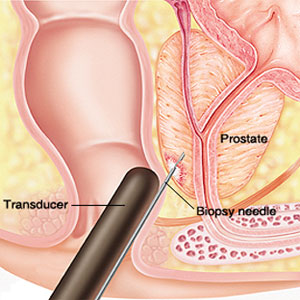
A prostate biopsy is a test to remove small samples of prostate tissue to be examined under a microscope. For a prostate biopsy, a thin needle is typically inserted through the rectum, under the guidance of an ultrasound (TRUS) probe. The tissue samples taken during the biopsy are examined for cancer cells by the pathologist.
A biopsy may be done when a blood test shows a high level of prostate specific antigen (PSA) or after a physical examination finds an lump in the prostate.
A prostate biopsy is done to determine:
- Whether a lump found in the prostate gland is cancer.
- The cause of a high level of prostate-specific antigen (PSA) in the blood.
Tell your doctor if you:
- Have had any bleeding problems.
- Are allergy to any medications, including anesthetics.
- Take any medications regularly. Be sure your doctor knows the names and doses of all your medications.
- Are taking any blood-thinning medications, such as warfarin, heparin, enoxaparin, aspirin, clopidogrel, ibuprofen, or other nonsteroidal anti-inflammatory drugs (NSAIDs).
A blood test (coagulation profile or PT/APTT/INR) is performed before the biopsy to ensure normal blood clotting ability of the body. An enema is usually given before the biopsy.
Prostate biopsy is usually done as a daycare procedure with about half a day spent in the hospital. Before your prostate biopsy, you will be given antibiotics to prevent infection. You will be asked to change to hospital clothing. Transrectal ultrasound (TRUS) is used to guide the needle to the correct biopsy location. A prostate biopsy is usually done with a spring-loaded needle. The needle quickly enters the prostate gland and removes a tissue sample. Multiple tissue cores (12 – 14) are removed to represent all the areas of the prostate. Additional areas may be sampled if any suspicious area is has been detected on the prostate MRI performed earlier. A transrectal biopsy procedure usually takes about 5 minutes.
For a transrectal biopsy, you may feel pressure in the rectum while the ultrasound probe or guiding finger is in place. You also may feel a brief, sharp pain as the biopsy needle is inserted into the prostate gland. Usually several biopsy samples are collected. With local anesthesia, most patients are able to tolerate this procedure well.
Following the biopsy, you will be asked to avoid strenuous activities for about 4 hours. You may experience some mild discomfort in the biopsy area for 1 to 2 days after the biopsy and may notice some blood in your urine. Also, you may have some discoloration of your semen for up to one month after the biopsy. If you had a transrectal biopsy, you may experience a small amount of bleeding from your rectum for 2 to 3 days after the biopsy.
A prostate biopsy has a slight risk of causing problems such as:
- Infection - Usually, taking antibiotic medication before the biopsy prevents an infection from developing.
- Bleeding - This may occur from the rectum or the urinary passage, mixed with urine or separately. You may see some clots. Usually it resolves on its own in 2 - 3 days.
- Difficulty in passing urine due to swelling of the prostate or bleeding.
- An allergic reaction to the anesthetic medications used during the biopsy.
Report to the emergency immediately if you:
- Have heavy bleeding or bleeding continues longer than 2 to 3 days.
- Have increased pain.
- Have a fever.
- Are unable to urinate within 8 hours.
A prostate gland biopsy is a test to remove small samples of prostate tissue to be examined under a microscope. Results are usually available within 5 days.
| Normal | The prostate gland tissue samples appear normal under the microscope, with no signs of infection or cancer. |
| Abnormal | Cancer cells (prostate cancer) or signs of infection (prostatitis) are found. |
If cancer cells are present, a grade (Gleason score) will be given, which your doctor will discuss with you. The Gleason score is considered a tool for predicting how aggressive the cancer is.
Factors that can interfere with your test or the accuracy of the results include:
- The biopsy may not contain enough tissue to make a diagnosis.
- A chance that a cancer may be missed since the biopsy takes a small amount of tissue.
- Normal prostate biopsy results do not completely rule out cancer.
-A prostate gland biopsy does not cause problems with erections and will not make a man infertile.